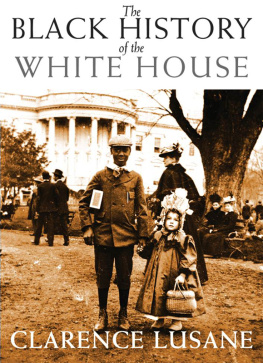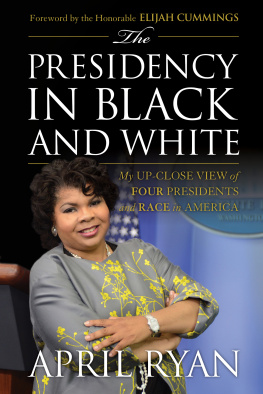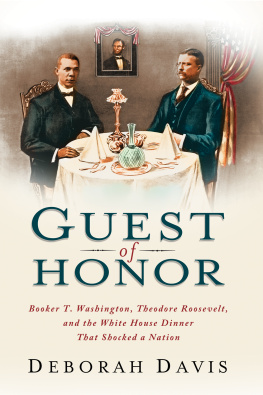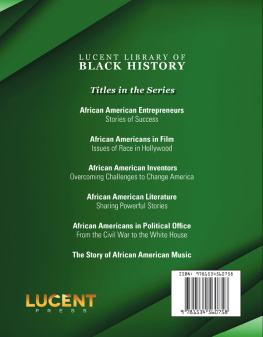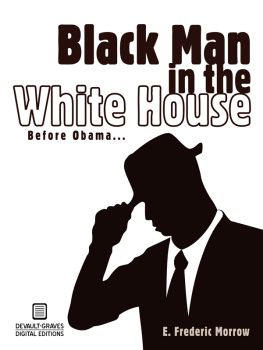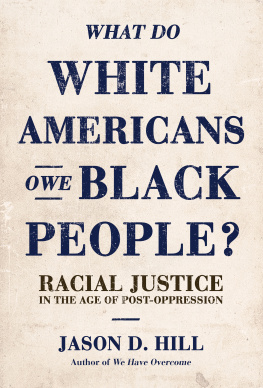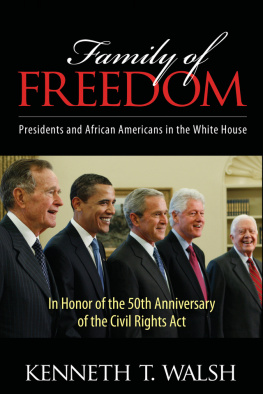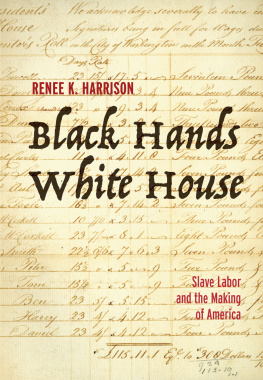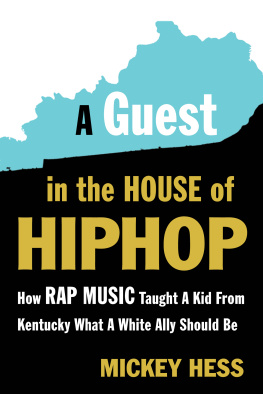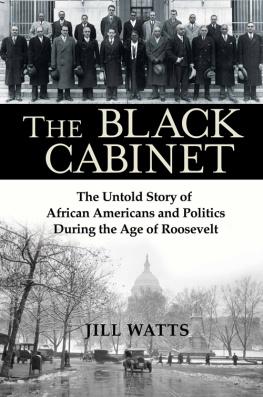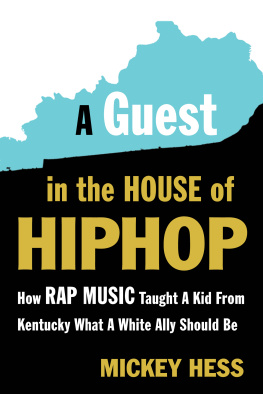All Rights Reserved.
The Open Media Series is edited by Greg Ruggiero and archived by the Tamiment Library, New York University.
The Black history of the White House / by Clarence Lusane.
p. cm. (Open media series)
Includes bibliographical references and index.
1. White House (Washington, D.C.)History. 2. African AmericansWashington, D.C.History. 3. African AmericansWashington, D.C.Social conditions. 4. African AmericansWashington, D.C.Biography. 5. PresidentsRelations with African AmericansHistory. 6. PresidentsUnited StatesRacial attitudesHistory. 7. PresidentsUnited StatesStaffHistory. 8. SlaveryWashington, D.C.History. 9. United StatesRace relationsPolitical aspects. I. Title.
ILLUSTRATIONS
What the White House looked like while human trafficking and enslavement of black people was thriving in Washington, D.C., 1858. (Library of Congress, Prints and Photographs Division)
African American school children facing the Horatio Greenough statue of George Washington at the U.S. Capitol, circa 1899. Photograph by Frances Benjamin Johnston. (Library of Congress, Prints and Photographs Division)
President-elect Barack Obama was about to walk out to take the oath of office. Backstage at the U.S. Capitol, he took one last look in the mirror. January 20, 2009. (White House website)
The building where the first president of the United States lived with his family and the blacks they enslaved, High Street, Philadelphia. Breton Lithograph from John Fanning Watsons Annals of Philadelphia (Philadelphia, 1830). (Library Company of Philadelphia)
Hercules, cook for George Washington, one of hundreds of blacks Washington enslaved in his lifetime. Painting by Gilbert Stuart, oil on canvas, circa 179597. ( Museo Thyssen-Bornemisza, Madrid)
Anthony Benezet instructing black children. (Pennsylvania Historical Museum Commission, Historical Poetical and Pictorial American Scenes, by J.W. Barber, 1850)
Slave pen, Alexandria, Virgina, circa 1863. Photograph by Andrew J. Russell. (Library of Congress, Prints and Photographs Division)
)
, Historical Documents)
The famous Gilbert Stuart painting of George Washington that was removed from the White House just before the British army sacked and burned it in 1814. Oil painting by Gilbert Stuart, 1796. (Library of Congress, Prints and Photographs Division)
View from northeast of the damaged White House after the British army looted and burned it on August 24, 1814. Hand colored aquatint by William Strickland. (Library of Congress, Prints and Photographs Division)
Poster of Blind Tom. (Library of Congress, Prints and Photographs Division)
Inauguration of President Lincoln at U.S. Capitol, March 4, 1861. (Library of Congress, Prints and Photographs Division)
Portrait of Elizabeth Keckly, 1861. Photographer unknown. (Moorland-Spingarn Research Center, Howard University)
Group of black contrabands make it to a Union camp during the Civil War. Wood engraving, from Frank Leslies illustrated newspaper, vol. 18, no. 464 (August 20, 1864), p. 340. (Library of Congress, Prints and Photographs Division)
Frederick Douglass, circa 1855. (Library of Congress, Prints and Photographs Division)
Marching on!The Fifty-fifth Massachusetts Colored Regiment singing John Browns March in the streets of Charleston, February 21, 1865. Wood engraving in Harpers Weekly, v. 9, p. 165, March 18, 1865. (Library of Congress, Prints and Photographs Division)
The White House as it appeared around the time Frederick Douglass went there for meetings with President Lincoln. (Library of Congress, Prints and Photographs Division)
Sojourner Truth and President Lincoln in the White House, October 29, 1964. (Library of Congress, Prints and Photographs Division)
Earliest known photo Harriet Tubman, taken when she was already established as the Moses of her people. Photograph by H. B. Lindsley. (Library of Congress, Prints and Photographs Division)
Booker T. Washington, circa 1895. Photograph by Frances Benjamin Johnston. (Library of Congress, Prints and Photographs Division)
Black woman working in the White House kitchen, circa 1892. Photograph by Frances Benjamin Johnston. (Library of Congress, Prints and Photographs Division)
African American school children and teacher, studying leaves out of doors, circa 1899. Photograph by Frances Benjamin Johnston. (Library of Congress, Prints and Photographs Division)
The first black senator and representativesin the 41st and 42nd Congress of the United States. Currier & Ives, 1872. (Library of Congress, Prints and Photographs Division)
Video from the pro-KKK film, Birth of a Nation, 1915. Film directed by D. W. Griffith. (Epoch Film Co., Madacy Entertainment)
Jubilee Singers, circa 1875 (Library of Congress, Prints and Photographs Division)
Frederick Douglass with his grandson, Joseph Henry Douglass, the violinist. (Courtesy of The Frederick Douglass Family Foundation)
Marian Anderson, 1940. Photograph by Carl Van Vechten. (Library of Congress, Prints and Photographs Division)
Civil rights leaders meet President Eisenhower, June 23, 1958. From left to right: Lester Granger, Dr. Martin Luther King, Jr, E. Frederic Morrow (White House Staff), President Eisenhower, Asa Phillip Randolph, William Rogers (Attorney General), Rocco Siciliano (White House Staff), Roy Wilkins. Photographer Unknown. (Dwight D. Eisenhower Presidential Library & Museum)
Martin Luther King Jr. meets with President Lyndon B. Johnson in the White House Cabinet Room, March 18, 1966. Photograph by Yoichi R. Okamoto. (Lyndon Baines Johnson Library and Museum)
Civil rights march from Selma to Montgomery, Alabama in 1965. Photograph Peter Pettus. (Library of Congress, Prints and Photographs Division)
Condoleezza Rice in London, England on March 1st, 2005. Photographer Unknown. (United States Department of State)
Eli Yamin, Todd Williams, Stephen Massey, Sean Jones, First Lady Michelle Obama, Wynton Marsalis, Artistic Director, Jazz at Lincoln Center, Branford Marsalis, Jason Marsalis, Ellis Marsalis, Delfaeyo Marsalis at the White House, June 2009. (Photo courtesy of The White House)
Marcus Garvey August 5, 1924. (Library of Congress, George Grantham Bain Collection)
Congresswoman Shirley Chisholm announcing her candidacy for presidential nomination, January 25, 1972. Photograph by Thomas J. OHalloran. (Library of Congress, Prints and Photographs Division)
Eldridge Cleaver speaking at the Woods-Brown Outdoor Theatre, American University, October 18, 1968. Photograph by Marion S. Trikosko. (Library of Congress, Prints and Photographs Division)
First Lady Michelle Obama in the White Houses Blue Room, February 18, 2009. Photograph by Joyce N. Boghosian. (Library of Congress, Prints and Photographs Division)
President Barack Obama, First Lady Michelle Obama, and their daughters, Malia and Sasha, in the Green Room of the White House, September 1, 2009. Photograph by Annie Leibovitz.

